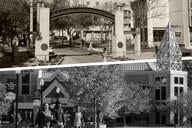You have /5 articles left.
Sign up for a free account or log in.
His house faces east. Its dimensions are anything but arbitrary. Each room is perfectly in its place in accord with ancient understandings of natural law.
“The houses have been called fortune-creating houses,” says Christopher Jones, an associate professor of education at Maharishi University of Management. Officials at the Iowa institution are overseeing the systematic demolition of the entire physical plant in favor of new “fortune-creating” buildings designed according to principles of Maharishi Vedic architecture. Jones lives in one of 12 such homes constructed privately by faculty and staff on land provided to them on the undulating 272-acre campus.
“What I’ve noticed most of all,” Jones says, “was just a sense of greater support – meaning that I just felt as though there was a kind of unseen hand that was supporting what I was doing.”
At Maharishi, where students, faculty, staff and townspeople congregate at two gold-domed structures for Transcendental Meditation sessions, 43 of 70 original buildings have been demolished since 2000, when the board resolved to de- and reconstruct the entire, million-square-feet of buildings on campus (originally purchased by Maharishi from a defunct liberal arts college in 1974, one year after the "consciousness-based university" first opened in a rented Santa Barbara motel complex).
Now midway through the reconstruction process, Maharishi's campus boasts 70 new buildings built since 2000 – all conforming to the principles of Maharishi

The home of the departments of Management and Development of Consciousness.
Vedic architecture, a system of design derived from ancient Sanskrit texts (as reinterpreted, or "restored," by the university’s founder, Maharishi Mahesh Yogi – hence the “Maharishi” in the architectural style’s moniker).
In this style and on one of the highest points on campus, the flagship $7.5 million, 48,000-square-foot Argiro Student Center will open Friday. It will be home to a dining hall serving organic vegetarian foods, largely locally grown in a 10-acre garden and 1-acre greenhouse right on campus. It will also house an auditorium, bookstore, student lounge, mail room, conference room, exercise area, and festival hall for religious services.
“All the buildings that we build are completely nourishing,” says Jonathan Lipman, Maharishi's campus architect for the past decade. Among the principles guiding the new construction, he says, are those manifested in Professor Jones’ house: orientation toward the rising sun rays of the east, believed to be the most nourishing, a reliance on a set series of dimensions, and the placement of rooms in different areas of a building based on varying solar energy levels. “Differing qualities of energy of the sun should align with the appropriate different activities in a house so that natural law always supports our daily activity,” Lipman says. "What this means, in practical terms if we're building a house is that there's a most nourishing place to cook food. And if we pray at home or meditate at home, there's a most nourishing place for those deep, nourishing activities."
When asked the three-letter question – why? -- Lipman audibly smiles into the phone. “When we encounter any principle of natural law, it is what it is,” he says. “It has something to do...with the influence of the sun.” Lipman also cites peer-reviewed research on brain function relative to orientation, navigation and function to support the argument that there's a scientific basis behind the architectural style, as well as some mostly unpublished preliminary research, some of it conducted at Maharishi, relative to building orientation and occupant mind/body health. These include a cardiologist’s finding that a disproportionate number of patients live in houses facing south, supposedly the least nourishing direction, and a study finding that hospital patients whose rooms let in eastern light stayed for an average of four fewer days than their western-facing brethren. (More broadly speaking, the university promotes its practices as empirically supporting health and well-being worldwide. A Maharishi spokesman recently distributed a press release asserting a direct causal link between the creation of a more "coherent national consciousness” by 1,700 Transcendental Mediators at Maharishi to drops in violence in major U.S. cities and Iraq, a cooling of nuclear tensions between the U.S. and North Korea, an increase in the Dow Jones index, and a calmer-than-expected hurricane season).

A new classroom and office building.
Maharishi’s management believes deeply in the principles guiding the campus reconstruction, to the tune of $7.3 million raised and another $10 million borrowed. Including the new student center and two "peace palaces" for Transcendental Meditation instruction set to open this spring, 29 of the 70 new buildings on campus are university buildings – five major administrative and academic buildings, six small residence halls, 12 homes and one condominium building for faculty and administrators, one media center, one natural food store, and the "Maharishi Tower of Invincibility." There are also 12 more privately built homes for faculty and staff (including Jones') and 29 commercially constructed new buildings on campus land. “There’s a principle that the more buildings you have in a community that are built according to these principles, the stronger the effect on a community,” says Craig Pearson, Maharishi’s executive vice president.
Next on tap is a Sustainable Living Center that Maharishi administrators hope to build "off the grid" in terms of energy and water use and waste. (Building sustainably is also a goal of the rebuilding process -- as is building for health in ways more easily understood by Western medicine. Lipman stresses that in the reconstruction, he considers everything down to the toxicity of carpet glue in order to create healthy indoor climates). The university is also in the planning stages for a 22-unit “Golden Dome” apartment complex and one or two more student dorms officials hope to build this year.
“We want the students to have every possible advantage for the growth of their health, the growth of their well-being, and the personal growth from within,” Pearson says. “When we have the prospect of a system of architecture that is said to promote clarity of thought, greater well-being…then we thought, ‘Well, that’s just terrific.’”
“It’s been quite a lot of activity in these last eight years,” Pearson says. "It’s not unusual to step outside and just hear hammering, buildings coming down and the hammering of new construction coming up."




